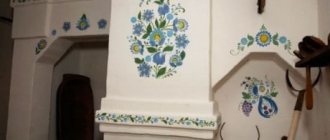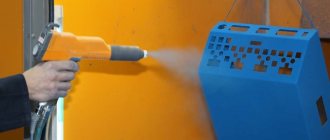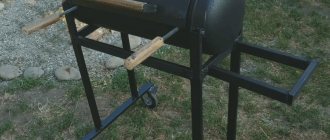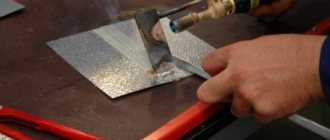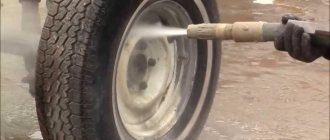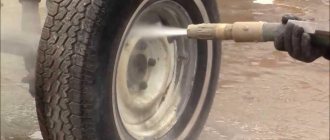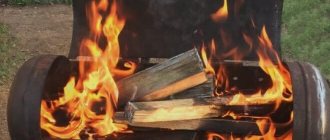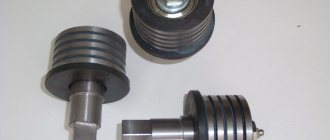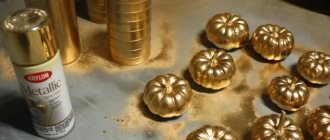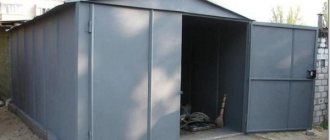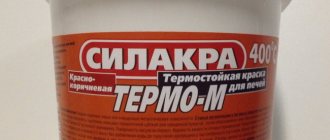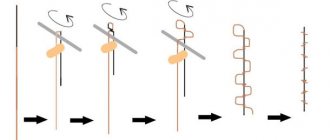What causes the need for coloring?
Experts recommend painting with special paints to ensure 2 main functions:
- protective, since the thin zinc layer gradually becomes thinner and becomes unable to withstand negative natural influences;
- A decorative, varied color palette, instead of the original gray color, will give the metal structures and the entire building an original and attractive appearance.
Based on the results of numerous experiments, it was concluded that it is best to paint galvanized iron after a year, during which time the galvanized sheets will “age” naturally, the surface will acquire a roughness that improves adhesion when applying paint. If it is necessary to carry out painting at an earlier date, the surface of the sheets is treated with abrasives.
Why paint galvanized iron
Galvanized metal does not rot or rust under the influence of the environment.
Galvanized metal does not rot or rust under the influence of the environment. Therefore, at first glance, there is no reason to paint this material. But if we consider the real situation, then everything is somewhat more complicated.
Zinc is one of the rather soft metals, so scratches may appear during transportation or installation, the depth of which reaches 0.1 mm. A galvanized roof does not withstand the abrasive effects of wind due to dust and fine sand. As a result of prolonged exposure to galvanized metal, stripes may appear on it without protection. Most often this is observed in the area of the ridge, roof overhangs or eaves.
If the roof is not painted on time, a white coating may soon begin to form and after that the corrosion process will be quite problematic to stop.
It is worth noting that after the zinc layer is erased from the metal, corrosion begins to penetrate under the protection itself. Because of this, the damaged area may be much larger than it appears at first glance.
Why can galvanized corrugated sheets rust?
To produce profiled sheets, special rolled products with a galvanized coating are produced. Its main function is to exclude contact of the metal surface with the surrounding atmosphere. Any damage to the sheet coating leads to corrosion at this point and its complete unusability.
According to production technology, after applying a zinc coating to the metal, it is preserved using special oil-based compounds. Next, it is processed into a specific shape. At the same time, significant violations may occur during the production process, leading to damage to the coating.
Violations of the technology for applying zinc coating are expressed in insufficient quality of preliminary cleaning of the metal, or the application of a thin layer of zinc. Sometimes leaf preservation technology is not followed.
Rust on the surface layer also occurs due to improper transportation. During transportation, as well as loading and unloading, the sheets are scratched. As a result, the integrity of the zinc layer is compromised. To eliminate the possibility of damage, manufacturers and sellers of corrugated sheeting must securely package it in film and fix it, preventing the possibility of shifting.
It can be very difficult to return defective sheets to the seller, and if the corrugated sheets are installed a long time after purchase, then this will not be possible at all. Therefore, when purchasing corrugated sheets, you should be present during loading and require sellers to fold the sheets one piece at a time. This will allow you to carefully inspect them on both sides for damage and corrosion.
Most often, rust occurs in places where sheets are cut. Especially when grinders or jigsaws are used for these purposes. To prevent the formation of corrosion, cut areas must be treated with protective compounds.
Sometimes rust marks on galvanized corrugated sheets are not a consequence of corrosion. For example, they occur when rusty water drains from an unprotected metal frame in rainy weather.
If rust appears on the corrugated sheet, the damaged area must be carefully cleaned with fine sandpaper until clean metal appears. Then it is treated with a special rust converter, produced for processing corrugated sheets and other metal roofing materials. The chemicals contained in the converters partially restore the crystal lattice of the metal, preventing further rusting. Then the metal is primed and coated with paint of a suitable color. There is no point in restoring corrugated sheets with extensive corrosion stains. Damaged sheets are cheaper to replace.
What requirements must paint compositions meet?
When selecting paints, it is necessary to take into account the presence of the following mandatory properties:
- providing long-lasting protection from negative atmospheric factors;
- galvanized paint should not fade under sunlight;
- possessing high elasticity and adhesion;
- good hydrophobicity, providing resistance to moisture in the form of rain and snow;
- sufficient frost resistance and resistance to temperature changes when used for outdoor work;
- quick drying;
- ease of application;
- harmless to human health and the environment;
- attractive appearance.
Types of paints
Painting galvanized steel, which has a high degree of passivity, is recommended to significantly increase the service life. When choosing how to paint galvanized steel so that the paint does not peel off, the mandatory presence of elastic characteristics and good adhesion quality are taken into account.
Not all paints and varnishes will be able to cope with the task. For this purpose, alkyd, acrylic, rubber, and vinyl enamels can be considered.
Painting galvanized steel, which has a high degree of passivity, is recommended to significantly increase the service life.
Acrylic
The first in the rating of products for painting galvanized steel is the acrylic type of paint. They create reliable protection and contain anti-corrosion substances as components. The following advantages are also noted:
- Resistant to temperature changes and ultraviolet radiation;
- Duration of operation;
- Moisture resistant property;
- High degree of adhesion;
- Good value for money.
Acrylic paints provide reliable protection; their components include anti-corrosion substances.
Alkyd
This type creates good protection. A glossy finish is created on the surface. They contain elements that help avoid corrosion on the material. It should be noted that the constituent components react with zinc, and as a result its structure changes in a negative direction.
Regularly chosen for painting near the ocean and sea.
This type creates good protection.
Vinyl enamels
Vinyl paints may be the best option for this material. According to a number of indicators, the vinyl type copes better than other enamels in protecting the material. They are distinguished by high rates of creating a barrier from surrounding factors.
They are distinguished by high rates of creating a barrier from surrounding factors.
Special coloring compounds
Painting galvanized sheets should optimally be done with special paints, which were developed for this purpose. You can use acrylic primers, which perform two functions - protection and creation of a beautiful coating. The cost is higher, but the resulting properties easily justify it. Some people choose paints with rubber crumbs, which also create a reliable coating for the material.
Painting galvanized sheets should optimally be done with special paints, which were developed for this purpose.
Imported paints
Among foreign products for painting galvanized steel with your own hands, buyers also highlight Tikkurila. “Hammerite” can be applied to metal that has already been corroded without prior preparation. However, over time, if there is corrosion, the layer will peel off, so it is better to clean this area in advance. The quality of foreign paints is good, but the price is higher than Russian ones.
The quality of foreign paints is good, but the price is higher than Russian ones.
Domestic products
Among Russian products, a special place is occupied by Tsikrol paint, which is distinguished by its high quality. This is a specialized product for painting galvanized steel. In addition to good performance characteristics, the possibility of painting without a priming step is noted.
Among Russian products, a special place is occupied by Tsikrol paint, which is distinguished by its high quality.
Rubber coloring compound
On sale you can find special rubber solutions that can be used to paint galvanized iron. They tolerate even prolonged exposure to moisture very well and can be used in different weather conditions. In addition, such compositions are completely safe for human health and are among environmentally friendly materials.
We recommend: How to level a wooden floor in a private house under laminate without screed (without tearing off the boards)
How to distinguish stainless steel from galvanized
Both materials are often used to construct coatings that are not susceptible to corrosion. Stainless steel has longer anti-corrosion properties, durability of up to 50 years and is more expensive, so unscrupulous sellers can slip galvanized steel to the buyer under its guise. After all, high-quality stainless steel is practically indistinguishable in appearance from galvanized steel.
The main differences visible upon external examination:
- if the sheets are thick enough, you can notice the heterogeneity of the galvanized product in the sections;
- The galvanized sheet may have individual characteristic spots, called crystallization patterns. In the absence of such spots, the surface is mirror-like with a slight bluish tint. The surface of stainless steel is more matte;
- magnets are not attracted to most stainless steels;
- zinc actively interacts with hydrochloric acid, therefore, when a drop of acid gets on the galvanized surface, swelling is observed with the gradual dissolution of zinc;
- galvanized steel is easily scratched by a nail.
The most accurate determination of the type of material can only be carried out by spectral analysis, but this requires the availability of appropriate equipment and instruments, as well as time costs.
The last method is to select suppliers from well-known companies that have been working in the sales market for a long time, and legally competent registration of the purchase with the provision of quality certificates.
- Roof
- Exterior finishing
Polyurethane paints for galvanized roofs
Coatings based on polymer urethane resins are considered more resistant to external loads. Experts recommend using polyurethane paint and varnish compositions in cases where there is a huge amount of sand, ice and other materials on the roof that have an abrasive effect on the galvanized coating.
Polyurethane and alkyl-urethane paints perfectly preserve the color scheme; it is believed that it is best to paint old and fairly worn roofs with such materials. For example, inexpensive “Unikom” adheres perfectly and is held on to a metal roof that has been worn to holes, even if areas and traces of galvanized coating remain on the surface. Whereas, before using the most popular acrylic composition “Tsikrol”, it is best to first paint the roof with a primer that improves adhesion to zinc.
SIA "AB Baltic" - Roof care
So that the roof lasts a long time.
For the roof to last a long time! The roof of the house must always be in excellent condition, and the people who live under it also want to see it well-groomed. Repairing a metal roof is difficult and expensive, not to mention new decking, so the homeowner needs to monitor its condition from time to time and understand the products and paints. It is common practice to paint a metal roof, and to ensure that the paint lasts longer, the metal surface is cleaned before painting. But in winter and summer, the metal becomes deformed, the paint peels off, moisture gets on the metal, and rust begins to appear. Further, the rust becomes more and more and goes up into the paint layer. Trying to hide unsightly brown spots, home owners try to repaint. Beautiful, freshly painted roofs look good from a distance, but up close they show signs of rust. In addition, after a short time, the paint begins to peel off again; it is destroyed by the rust remaining underneath, which is almost impossible to eliminate. Then all that remains is to paint again once every year or two, because the process cannot be stopped, and the rust spreads further. To repair a painted roof that is showing rust, you must first completely remove the old paint. It is customary to use various solutions - rust converters. But when using them, you need to know exactly the amount of solution required to react with rust. If there is too little solution, some of the rust will remain and it will continue its destructive effect. In turn, if there is too much solution, the unreacted part of it will again spoil the roof and the new paint applied. It is almost impossible to accurately guess the required amount of rust converter, so the result is difficult to predict. When deciding to give a fresh tone to a metal roof, you also need to remember that not every paint will stick to a previously galvanized roof. Fighting rust In order for the metal roof of a house to serve for a long time, even before laying it, you need to think about how to protect it from rust and how often you will have the opportunity to take care of it. The metal roof must first be carefully treated. If you do not pay enough attention to this, then later, after its installation, you will have to face serious problems and tasks, for example, the annual painting of a rapidly rusting metal surface. There are various methods for protecting metal from rust, but still nothing more suitable and acceptable than zinc has been found, explains metalworking director Andrei Bengard. Galvanizing can be done in various ways. One option is hot-dip galvanizing, where iron sheets, structures and components are placed in a bath of molten zinc. This can also be done in a bath with a solution of zinc salts (electrolyte), where, under the influence of an electric current, zinc molecules are deposited on metal products. Before hot-dip galvanizing, the metal must be kept in an acid solution to remove the covering hard surface layer, which over time, as a result of temperature fluctuations, begins to peel off and allows rust to appear. The acid reacts with the solid surface layer and makes it possible to get to pure metal, which is immediately hot-dip galvanized. However, there is no guarantee that there is no unreacted acid remaining under the zinc layer, which can later be dangerous for the paint. Therefore, after hot-dip galvanizing, it is recommended to paint only after 6 months. However, if it is necessary to paint as early as possible, then first it is necessary to treat the surface with ammonia, then with a special primer and then apply a special paint. But even then there will not be a complete guarantee that the paint will stick.
Zinc helps the metal Zinc acts as a barrier that protects iron from weathering, moisture and rust. If the zinc content in the coating is very high, then it acts not only as a barrier, but also actively fights rust. In places where rust appears on the roof surface, zinc reacts with it, consuming itself, and renewing the metal molecules. The resulting zinc compound is very hard and resembles black graphite; it serves as an additional protective barrier.
Zinc as an active element is therefore consumed both from the inside, reacting with rust, and from the outside, in contact with the atmosphere and rainwater (on galvanized roofs you can usually see dark spots - traces of zinc corrosion). The service life of the roof covering will depend on the thickness of the applied zinc layer. Typically, zinc is applied at an average thickness of 100 microns. Depending on the climatic conditions in which the house is located, the atmosphere annually destroys 5-10 microns of the zinc layer. In salty sea air, which is very aggressive, the destruction of zinc occurs faster, and in temperate climates it occurs more slowly. Losing 5 microns annually, the zinc layer on the roof will last 20 years. When there is no longer any left, rust spots will begin to appear on the surface of the roof. This means that all the zinc has already reacted and must be reapplied. The most convenient and cheapest method for this purpose is cold galvanizing: first, the crumbling and loose layer of rust is cleaned off with a metal brush, then zinc powder dissolved in a liquid base is applied from a container with a roller or brush. Unlike the previous method, cold galvanizing can be used on already installed roofs or to repair them. There is no need to remove all the rust, you just need to provide the necessary layer of zinc to stop metal corrosion. The price of such zinc material is on average 1.5 lats per 1 sq. meter. Of course, further costs are associated with the contractor, who determines the complexity of the object, etc. A certain composition of the base allows zinc to integrate into the structure of the metal crystal lattice. At the same time, such a zinc coating is not hard, but elastic, which is important in changing temperature conditions and in cases where the metal surface is curved. Repairs will be cheap, and metal products can be used forever. After cold galvanizing, the roof surface is not shiny (as it can be in the first years after hot galvanizing), but matte, because zinc has a gray color.
Complex protection To prevent a metal roof from rusting for many years, complex protection is used: first, zinc is applied, and then paint, thus increasing the service life of the coating by 1.5 times. A layer of paint protects the zinc from rain, adverse weather conditions and destructive atmospheric impurities, so that the zinc does not corrode. In turn, zinc fulfills its task and stops the development of rust, does not allow it to destroy and lift up the paint. After cold galvanizing, the roof can be painted the very next day. But you need to carefully choose the paints applied to the zinc layer, because... paints are prepared on different bases. Copper can be used to achieve different tones. If the paint contains aluminum and copper impurities, when it gets on the zinc surface, the polarity of non-ferrous metals changes - if before this zinc could renew the metal coating of the roof, now it destroys the paint. If you plan to paint with epoxy paint, then when galvanizing you need to choose an epoxy-based zinc solution, which will ensure good adhesion. In St. Petersburg, where the cold galvanizing method has been developed, zinc mass is produced on a base compatible with alkyd paints. In turn, if someone wants a shiny roof, they can cover it with a special aluminum-based paint that is designed to be compatible with zinc. As for aluminum paints, they can be placed on top of zinc - these coatings complement and protect each other. Such a roof does not become dark, and zinc corrosion stains also do not appear on it.
abbaltic.lv
Paint requirements
When choosing paint for painting galvanized iron, it is necessary that the composition has certain properties.
- Protected for a long time from exposure to moisture and precipitation.
- The paint should not lose its color when exposed to sunlight.
- The material must have a high rate of adhesion and elasticity.
- The composition must have excellent hydrophobicity, so galvanized iron can withstand exposure to precipitation well.
- Can be used for outdoor work, because it tolerates temperature changes well.
- Has an attractive appearance.
Requirements for coloring compositions
Not every paint is suitable for a smooth finish. It must have maximum adhesion, that is, ideally adhere to the surface. Since galvanizing, although to a lesser extent, is also susceptible to corrosion (as evidenced by the appearance of whitish spots on it), it is desirable that the paint contains anti-corrosion components.
Traditional alkyd compositions based on resins that can react with zinc, as well as oil paints, are not suitable for these purposes. They contain not only acids and alkalis, but also some additives that can destroy the galvanized surface. Therefore, paint and varnish materials used for painting must be neutral to zinc.
Paint on galvanized metal intended for exterior use must be frost- and chemical-resistant and resistant to UV rays. Particular attention must be paid to its elasticity - after all, zinc changes dimensions when the temperature changes. Regular paint will crack and peel during use. Naturally, the color should also be selected so that it matches the exterior of the other buildings.
Deciding on the dye
How to paint galvanized steel must be decided at the beginning of the work or even at the planning stage, since not every coloring composition may be suitable for the surface. Standard painting of galvanized elements is quite primitive, and therefore, in order for galvanized products to be combined with the overall interior of the building, they are additionally painted in the desired color.
The main purpose of zinc coating is to decorate and protect steel surfaces, elements and structures from negative external factors.
Nuances when working with galvanized surfaces
When planning to work with elements made of galvanized steel, the following points should be considered:
- You should choose a material that contains not only special additives to increase grip on the steel surface, but also anti-corrosion elements
- Galvanized products cannot be treated with paint and varnish compositions that contain chemicals that contribute to the destruction of zinc, for example, various anti-corrosion additives, acids, solvents and alkalis;
- For structures operated in harsh aggressive environments, it is necessary to use specialized compositions - electrically conductive and fire-resistant paints for metal products;
- Galvanized coatings have a smoother surface compared to untreated surfaces of the material, and therefore adhesion to other materials will be lower. Based on this, before painting galvanized steel, you should carefully prepare the working surface, increasing the adhesion of zinc to the new paint and varnish composition;
- It is also important to pay attention to the degree of elasticity of the material, since a coating with poor elasticity will simply crack and delaminate on a metal surface, which is characterized by slight changes in shape when heated and cooled. All this will lead to the fact that the composition will simply completely “peel off” from the steel surface over time.
We recommend: How to make liquid wallpaper with your own hands: composition and methods of making it yourself at home from paper, what is included, how much it costs, the correct technique
Important point! Paint for zinc should not negatively affect the characteristics of steel; it must have good adhesion, high elasticity and resistance to external negative factors.
Choosing a Zinc Coating
Steel surfaces can be treated with various colorants:
- Polymer paints, which can vary greatly in their characteristics. Today, ground enamels, as well as latex and polymer compositions, are distinguished. In practice, despite the high cost, ground enamels have proven themselves to be excellent;
- Alkyd compounds that perfectly protect metal surfaces. In addition, they stand out for their considerable service life and a wide range of colors;
- However, alkyd paints are not recommended for use as a protective agent for galvanized products due to the fact that the paint contains aggressive components that can affect the surfaces of steel elements!
- Oil paints. The characteristics of the coloring composition allow it to create a film on the treated coating that does not allow water to pass through. Thanks to this, the galvanized product becomes well protected from the effects of snow and rain. At the same time, such paints have good adhesion to steel. However, oil-based paints also contain substances that can react with zinc, causing its destruction. Based on this, it is not recommended to use such products for painting galvanized steel.
- When choosing a paint composition to protect steel elements, it is better to give preference to acrylic primer enamels containing neutral substances that cannot have any negative effect on steel!
The cost of paint can vary greatly. By and large, the price will depend on the manufacturer and the volume of the can. When purchasing, you should choose products from a trusted manufacturer. If you plan to do the painting work yourself, the final cost will be lower!
Painting technology
In order for painting metal with your own hands to bring the desired result, you should carefully study the instructions on the container with paintwork materials and strictly adhere to them, then the treated surface will be able to maintain a good appearance for a long time.
Tools and equipment
For the classic method of painting metal, you need to prepare:
- roller, brushes of different widths;
- paint container;
- the coloring composition must be shaded;
- primer for metal.
Additionally, you will need masking tape and plastic film.
Application methods
To apply paint you can use:
- Paint brush. Suitable for painting small parts. You can find brushes of different sizes on sale. The bristles can be natural or synthetic. For access to hard-to-reach places, the tool is equipped with an elongated curved handle.
- Roller. Suitable for painting large flat surfaces.
- Sprayers. The second name for the spray gun. A compressor is used to operate them. The coloring composition is supplied under pressure. The equipment is used by large enterprises, car repair shops, carpentry, and blacksmith shops.
- Containers for dipping metal workpieces. This method makes it easy to paint parts with complex shapes.
Modern technology - powder coating of metal. The blanks are placed in a closed spray booth and covered with a layer of paint. Its particles receive a negative electrical charge and are attracted to the working surface, creating a dense, uniform layer. After applying the powder, the workpiece is placed in an oven so that the decorative layer bakes and becomes monolithic.
Preparing for painting
Before you begin painting galvanized metal, the surface to be treated should be well prepared. And, in particular, carry out work that increases the adhesion of the zinc coating.
In order for the paint composition to lie evenly and tightly on the galvanized surface, it must be absorbed and penetrate its natural microdeformations. If there are few of them, or they are practically absent, they should be created artificially. Often, for this purpose, the surface to be treated is coated with an abrasive substance.
There is another good way - if the galvanized surface (in particular, the roof) has been in contact with air for a long time - half the job is already done, since in one year fresh zinc, or rather its surface, has time to react with oxygen, while coated with a layer of oxide, which absorbs paint remarkably well. But nevertheless, even such zinc should be slightly cleaned and degreased with a solvent.
When choosing any materials for painting a roof or other galvanized surfaces, it is best to pay attention to abrasives, primers, paints and solvents from the same company, since the chemical components in them are specially selected for joint use.
Creating a protective layer on the surface
If the zinc surface has previously been coated with a layer of paint, it should be cleaned of any remnants of these materials. To do this, it is best to use a solvent and a metal brush. This work should be carried out carefully, since it is not at all advisable to remove the zinc layer along with the paint layer from the roof.
After this, again, you need to clean the surface of any remaining dirt that has formed. You can use an alkaline detergent for this.
Painting galvanized metal
Immediately before application, the coloring matter should be thoroughly mixed and poured into a special tray. It is best to apply a thin layer of paint with a roller, brush or spray. Before applying a new layer, you should wait until the previous one has dried.
It is optimal to paint in two layers. But to achieve maximum results, when the paint color will sparkle with more saturated shades, and the coating itself will have strong protective properties, you can apply three layers of paint and varnish material.
PREPARING THE SURFACE FOR PAINTING
In the question “how to paint galvanized steel so that the paint does not peel off,” you should adhere to certain recommendations for preparing the surface of galvanized steel:
Removing old paint using the stripping method
For these purposes, sandpaper or sandblasting is used. Cleaning is done so that the old coating is removed, but the base is not damaged.
Treatment with a degreasing compound
Degreasers allow you to remove dirt, grease, mold and other deposits from the surface that can impair the quality of the paint. At the same time, the degreasing composition does not damage the surface of the product itself. It is recommended to carry out treatment in small areas to prevent problem areas from being missed.
We recommend: Which pipes to choose for sewerage
For cleaning and degreasing, the following are most often used:
- White Spirit;
- Chlorine bleaches;
- Comet;
- Kerosene.
Drying
It is carried out until the surface is completely dry to prevent the degreaser from reacting with further applied products.
Removing white rust
White rust occurs as a result of the destruction of the galvanized layer under the influence of the environment and is a white powdery film. White rust can be removed using fine-grit sandpaper with a grit rating of 120 or less. Sanding is done with light circular movements. At the end of the process, the dust is removed with a slightly damp cloth or rags.
Abrasive treatment
To improve the adhesive properties, allowing the paint to adhere as firmly as possible to the surface being painted, the steel must be treated with abrasives and white (distilled) vinegar. The acid contained in vinegar will etch the galvanizing and give it a rougher structure; substances containing abrasive particles will help enhance the effect.
Exposure to vinegar is usually a minimum of 1-2 hours. It is worth considering that the longer the acid acts on the surface, the more pronounced the etching effect.
Padding
Most often, latex and epoxy primers for exterior use are used for these purposes. It is worth considering that due to its durability and resistance to damage, epoxy primer is optimal in cases where the product will be in the most aggressive conditions. The composition is applied with a brush or spray. The latter is most appropriate if we are talking about a large cultivated area. Application is carried out in a sectional manner, allowing for the most accurate distribution of the primer. Exposure time depends on the brand of primer mixture used and averages from 2 to 6 hours. You can start painting only after the primer has completely dried and there is no sticky effect.
Why do even galvanized and aluminum cars rot and rust?
I often come across misconceptions about galvanized cars. People believe that if a car is galvanized, it will not rot or rust. But, unfortunately, this is not always the case. And there are several reasons for this.
First, you need to understand that galvanizing is different from galvanizing. You can galvanize with a layer of 2 microns, or you can galvanize with a layer of 20 microns - this is the first. Secondly, there are a lot of galvanizing methods. Budget cars are usually galvanized in the most cost-effective way. As a rule, this is cold galvanized. Galvanizing occurs by painting the body with anaphoretic primers with a high content of highly dispersed zinc powder (zinc content in the finished coating is 89-93%). Such galvanization, of course, is better than nothing, but in fact, if the paintwork is damaged, it provides little protection from corrosion.
Manufacturers often use this type of galvanizing, because it is the cheapest and does not affect the price of the final product for the buyer as much as expensive galvanizing methods (in the budget segment, manufacturers fight for every penny). However, this gives them the right to say that the body is galvanized. First of all, this is necessary based on their marketing considerations.
Another fairly inexpensive method of galvanizing is zinc metal. In simple terms, this is ordinary steel coated with a special zinc-containing primer at the rolling stage. Zinc metal is good in regions where there is no high humidity, but in Russian conditions, especially if the paintwork is damaged, the metal still begins to rust. Maybe not as fast as bare steel, but still pretty fast. So you shouldn’t rely on life-saving galvanization in this case, as in the previous one. You need to quickly touch up chips and scratches.
A fairly good method of galvanizing is galvanic. This is when the body is bathed in a bath of zinc-containing electrolyte. Under the influence of an electric current, zinc is deposited on the metal in a uniform layer. Typically this layer is 5-20 microns. With this galvanizing method, manufacturers, as a rule, provide a guarantee against through corrosion of the body for at least 10 years.
Galvanic galvanization is rarely used on budget cars, because it is quite expensive, but on cars of the C-class and above it is quite common.
The best galvanizing method is hot-dip galvanizing. The dry, pre-prepared car body is simply lowered into a bath of hot zinc. The melt temperature is usually from 500 to 4000°C. This thermal method of body treatment is the best, but also the most expensive. Not all manufacturers, even premium ones, use it.
The zinc coating in this case is the thickest and most durable. With minor damage to the paintwork, the area of the chip or scratch may even become covered with zinc deposits - this process is called self-healing. In this case, even a damaged body may not rust for 5-8 years. As a rule, automakers provide an end-to-end warranty of 15 years or more for hot-dip galvanized vehicles.
However, you must understand that even the best galvanizing cannot protect the body from corrosion forever. If the paintwork is intact, then everything is fine, but if there is a chip, scratch or other consequences of an accident, then the zinc coating will protect the metal from corrosion only for the time being.
The fact is that the corrosion rate of zinc coating in atmospheric conditions is about 3 microns per year. In rural areas, where there are no aggressive chemicals, salt and reagents on the roads, the zinc layer lasts longer and is destroyed at a rate of approximately 1-2 microns per year, and in large cities and aggressive environments, the corrosion rate is much higher, from 3 to 7 microns in year.
Many people think that zinc does not rust, but this is not true. Corrosion eats away the zinc coating. The beauty of zinc coating is that as long as there is at least a little zinc, the metal will not rust. In simple terms, zinc simply gives you time to touch up and repair.
In general, if your paint has peeled off, a chip or a scratch has appeared, then it may not rust for several months or even years, but then it will definitely bloom, so it’s still better not to delay painting, because you can rarely know exactly how galvanized body. The presence of galvanization can only be proven or disproved experimentally or with the help of expensive laboratory tests.
Manufacturers very rarely disclose this information. As a rule, they are limited to general phrases that the body is galvanized. But they don’t say how galvanized it is. There is single-sided or double-sided galvanization. Sometimes only some of the exterior body panels are galvanized, but there is no zinc inside. Often, for state employees, only the most vulnerable places are galvanized. Often, with general galvanization, the roof remains ungalvanized.
Sometimes machines are grinded too vigorously during production and the zinc layer wears off. Sometimes there is no zinc on the welds. There are a lot of nuances. The manufacturer always tries to save money so that the final price of the car is as attractive as possible - this must be understood.
If we are talking about buying a used car, then you should not rely on galvanization. If the car has been in an accident, then often the owners themselves save money and buy cheap spare parts made of cheap metal without any galvanization.
As for aluminum cars, things are even more complicated with them. They do not rust in the usual red color. They are susceptible to electrochemical corrosion. It occurs at points of contact between different metals. For example, aluminum and steel. All-aluminum cars are still a rarity. Aluminum panels are often used, and the frame is steel. Or aluminum only the hood, fenders, roof and so on. It is in these places that the body will collapse and crumble first. No red color. Aluminum corrosion is similar to metal dandruff.
Advantages and disadvantages of the method
The pros and cons of painting metal depend on the type of paint composition used. Advantages of painting metal surfaces, provided the technology is followed:
- Getting the required shade. You can find different colors on sale.
- Availability of consumables.
- Easy to apply paint using a brush or roller.
- Protection against rust formation.
Flaws:
- Many types of coloring compounds emit a persistent, unpleasant odor. The room needs to be ventilated for a long time.
- For powder coating you will need special equipment, a spray booth.
- Not all types of paint protect metal from corrosion.
Most of the shortcomings can be leveled out if you buy a high-quality coloring composition and carry out the work strictly following the technology.
Why do galvanized and aluminum cars rust?
I often come across misconceptions about galvanized cars. People believe that if a car is galvanized, it will not rot or rust. But, unfortunately, this is not always the case.
Such a different galvanization
First, you need to understand that galvanizing is different from galvanizing. You can galvanize the body with a layer of 2 microns, or you can galvanize it with a layer of 20 microns - this is the first. Secondly, there are a lot of galvanizing methods. Budget cars are usually galvanized in the most cost-effective way. As a rule, this is cold galvanized. Galvanizing occurs by painting the body with anaphoretic primers with a high content of highly dispersed zinc powder (zinc content in the finished coating is 89−93%). Such galvanization, of course, is better than nothing, but in fact, if the paintwork is damaged, it provides little protection from corrosion.
Manufacturers often use this type of galvanizing, because it does not affect the price of the car so much (in the budget segment they fight for every penny). In addition, this gives the right to say that the body is galvanized - this is beneficial for marketing reasons.
Another budget method of galvanizing is zinc metal. In simple terms, this is ordinary steel coated with a special zinc-containing primer at the rolling stage. Zinc metal is good in regions where there is no high humidity, but in Russian conditions, especially if the paintwork is damaged, the metal still begins to rust. Maybe not as fast as bare steel. So you shouldn’t rely on life-saving galvanization in this case either. You need to quickly touch up chips and scratches.
How not to paint galvanized steel
Protective coated roofing material should not be painted with paint compounds containing high acid salts or alkaline soaps, commonly used in paints to promote adhesion and convert rust to iron phosphate. Unlike steel, the zinc layer quickly dissolves with the formation of amphoteric compounds, as a result of which the paint peels off and comes off the roof surface along with the galvanized coating.
The second limitation is the presence in the paint of special toners or pigments based on powdered copper, tin or antimony. If you paint galvanized paint with copper pimento paint, even in oxidized form, the process of degradation of the roofing coating still occurs, although at a noticeably lower rate than with direct contact with copper.
White corrosion and how to deal with it
The corrosion process of galvanized iron ends with the formation of white rust on the galvanized surface. It is a white chalky substance that forms zinc when exposed to hydrogen (from water) and oxygen (from air). As a result of this reaction, zinc hydroxide is obtained.
White rust on galvanized steel is typical for new material. This is due to the fact that such a coating has not yet had the opportunity to form stable oxides, so hydrogen and oxygen bind to pure zinc. White rust often appears on galvanized sheets during storage, as condensation can get into the gap between the individual sheets.
In most cases, white corrosion renders the protective coating useless. Unlike stable zinc oxides, zinc hydroxides do not adhere well to other materials. White rust is also unattractive from a visual point of view.
There are several ways to prevent white rust:
- Eliminate exposure to water.
- Eliminate condensation by allowing the zinc to form stable oxides.
- Use passivating chemicals or oils.
In the first case, it is necessary to improve the circular airflow of the product. Reasonably increasing the coating temperature or decreasing the relative humidity level is also effective.
Galvanizing is also corroded by prolonged exposure of the structure to a warm environment, since this intensifies the formation of condensate and, accordingly, zinc hydroxide. Another method of preventing white rust is to form stable oxides on the surface of the zinc. They will prevent the formation of white rust. To do this, allow the coating to remain in an environment with low humidity for some time. Increasing carbon dioxide in contact with the coating will also accelerate the formation of stable zinc oxides.
Protective equipment and precautions
We should not forget that toxic and flammable substances are used in the work, for this reason it is necessary to prevent any possibility of contact of paint with open fire. Smoking is strictly prohibited in the area. If work is carried out indoors, care must be taken to ensure that it is properly ventilated during and after work.
If you have a large volume of such work on a large area of the surface to be painted, get respirators to protect your respiratory tract. Do not forget to use special clothing, gloves and comfortable shoes.
- How to use
- Construction paints
- Working with paints
Our company will help protect against corrosion
We carry out galvanizing at our own production facilities. All work is carried out in strict accordance with GOST 9.307-89. Processing method: hot galvanizing of metal.
There are three reasons in favor of choosing a company:
- Three workshops for work. This speeds up processing orders. Production capacity is more than 120 thousand tons per year.
- The deepest galvanizing bath in the Central Federal District was installed. Its depth is 3.43 meters. This allows you to work even with large metal workpieces.
- A quality guarantee is provided. The work is carried out in strict accordance with GOST; equipment from such European companies as KVK KOERNER and EKOMOR is installed.
Leave a request or call.
We will choose the best coating composition depending on the area of use, answer questions about potential risks and calculate the duration of protection using galvanizing. We work with clients from all over Russia. Return to articles Share article
Features of painting a galvanized roof
There are several ways to paint a galvanized iron roof; the tools and painting techniques are practically no different from those used to apply paint to a regular metal surface, for example, when painting a metal gate or a black steel fence.
But zinc is an unusual metal; its structure is such that, regardless of the method of application to thin sheet steel, the galvanized surface is formed from a huge number of microcrystals. If you touch the galvanized surface with your fingers, the thin zinc film will seem slightly greasy, as if a small amount of silicone grease had been applied to it.
Sometimes would-be craftsmen, before painting a galvanized roof, treat the metal with a solvent, just as is done when applying paint to ordinary black steel. As a result, the paint lies unevenly on the roof surface, often even rolling off in microdrops.
Therefore, before painting galvanized iron on a roof, you will need, at a minimum, to properly prepare the surface and carry out a treatment that increases the adhesion and stability of the paint base.
Galvanized roof repair
This summer we had to urgently repair the roof at our dacha due to its constant leakage when it rained. It had leaked on the veranda before, but now, after heavy rains, there was just some kind of flood. The leak became very strong and in several places at once; repairs were urgently required.
The roof was made exactly 20 years ago, lined with sheets of galvanized iron, and at the joints of these sheets, most likely, discrepancies appeared, which became larger and larger over time. Last year, measures were also taken to seal the joints, they tried to do it with cement mortar, and then painted it, but all of these, as it turned out, were temporary measures and they did not lead to a long-term positive result. The cement cracked over time, fell off in some places, and it does not stick to galvanized steel. As a result, the problem continued to exist, the leak, if it disappeared for a short time immediately after sealing the joints with cement mortar, then dripping on the veranda began again, and over time it increased and turned into a flood.
I consulted with the men in the neighborhood, but everyone only offers the option of completely covering the part of the roof where the veranda is attached. This is either removing the galvanization completely, or somehow laying a new roof on top of the existing one. But I can’t afford this option at all, either in terms of buying slate or other material for roofing, or in terms of doing such work. I definitely can’t handle it myself, and hiring someone is an even greater expense than those that will have to be incurred when purchasing the necessary materials. Yes, and this is a long process. There is no hardware store nearby, you will have to go somewhere, look for and order everything you need, then the problem is to bring it, and then also find craftsmen. Therefore, I thought, I thought and decided to do everything myself with the minimum possible costs, both in terms of purchasing the necessary materials for repairs and in terms of personal labor costs.
So, in order to seal the existing joints as reliably as possible, I found the following materials - rubber-bitumen mastic, bitumen varnish and fiberglass, which for some reason is called self-adhesive serpyanka, although it is fiberglass, but the sellers do not know about it.
I first cleaned all the iron joints on the seams from dirt, both where the sheet is folded onto the sheet, and where the sheet meets the sheet joint. After that, I began to apply bitumen-rubber mastic to the joints of the bent iron. To do this, it is best to use two spatulas, one small with a width of no more than 4-5 cm, the other wider so that the remaining mastic can flow onto it. You will have to work very carefully so that the mastic does not flow or make streams on the roof in the wrong places; nevertheless, it is extremely viscous and thick. When scooping it out of the jar with a small spatula, you have to place another one underneath until you bring it to the joint that needs to be sealed. We apply mastic like ordinary cement mortar when we seal cracks, everything is elementary. But you need to take a little, because... After a certain time, there are still minor leaks towards the slope of the roof. Therefore, it is better to work not in sunny hot weather, but in cloudy weather. If the mastic has flowed, then you need to remove it from the surface in time.
But here are the seams where the galvanized sheets go end to end, i.e. The surface is almost flat, making it quick and much easier. I simply coated the seam of such a joint with bitumen varnish; I didn’t even use a brush for this, but an ordinary toothbrush, which turned out to be very convenient to work with. The varnish dries almost immediately. While the varnish is drying, you have time to cut a fiberglass ribbon (serpyanka) to the required length. Then I applied it to this joint, where the varnish had already dried, the adhesive base of the tape allows it to lie well on the surface, and I went over the top with the same varnish again, maybe even several times, so that it gets into the smallest cracks. This procedure is more pleasant in terms of execution and everything works out quite quickly. After some time, you can varnish the seams again, i.e. I varnished these joints three or four times.
During this time, the bitumen mastic also has time to dry out and you can also go over it with bitumen varnish for reliability.
This is how it was possible to repair a roof made of galvanized iron sheets in a fairly simple way and with quite accessible and inexpensive means. There was no need to completely cover the roof and spend a lot of money and a lot of time on it. I did it myself in two days, even without anyone’s help.
The next day it started to rain very heavily, as they say, like buckets of rain. I was afraid that my work would not hold up and would flood the entire veranda again, you never know, I still had concerns. I have already prepared cups, basins, and rags for the floor. It rained all night and there was no leak anywhere. The heaviest rain tested my work.
I didn’t stop there and decided that the black stripes from bitumen and varnish somehow don’t look very nice on a galvanized roof, which itself is light gray. Although these black stripes on the roof of the veranda are naturally not visible from below, they still need to be improved. Moreover, the galvanized sheets themselves in some places already have places where rust stains are clearly visible. Since I started doing it, I need to completely repair everything that can be repaired.
These rust spots need to be treated.
I bought a special gray anti-corrosion primer, it just happened to match perfectly with the color of the galvanized roof, i.e. You can also paint the roof itself on top, where there is rust, and cover the seams that were sealed with mastic with this primer, which will further secure the treatment of the seams.
The primer is practically the same as paint, so it is very quick and easy to work with a regular brush. I painted all the seams where bitumen mastic and bitumen varnish were applied, and then I went over the galvanized sheets and not only where there were rusty spots, but I painted the entire roof.
The drainage itself also requires treatment. It was like this:
It became like this:
Now my roof looks like new and doesn’t leak at all. By the end of summer, I’ll probably paint it again, but with a special paint, I’m thinking of taking “Tsikrol”, if I find it here, I’ll also choose a gray color, similar to galvanized.
So, before starting major repairs on the advice of “experts”, it is quite possible to do it with less money and time. Advising to do everything again is of course easier than figuring out how to carry out the repair work at a minimum cost.
houseinform.ru
Tips and tricks
Maximum surface quality can only be achieved in calm weather, so the best time to paint the roof is a quiet autumn morning. Cleaning and preparing the roof surface can be done the evening before the work.
The second layer is applied to the metal in the evening, after thoroughly drying the surface. During this time, it is important to inspect the applied first layer and identify flaws and places that require touch-up.
The last pass is to tint the details of the drainage system and the ridge.
